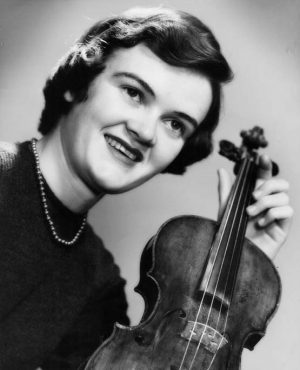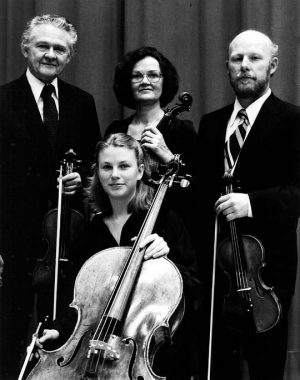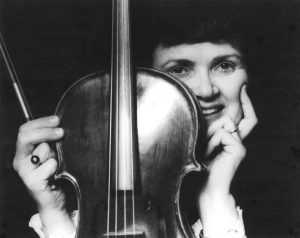Member Profile: Ruth Freeman – Viola “It Was A Thrilling Experience!”
by Alex Walsh
 The biggest thing that ever happened to Ruth Freeman was that she won an internal audition for promotion to the position of principal viola in the San Francisco Ballet Orchestra. This was in 1976, two years after the SF Ballet first established its own orchestra. Ruth was 45.
The biggest thing that ever happened to Ruth Freeman was that she won an internal audition for promotion to the position of principal viola in the San Francisco Ballet Orchestra. This was in 1976, two years after the SF Ballet first established its own orchestra. Ruth was 45.
“I didn’t move here until I was 37,” said Ruth. “To start a career in a major city when you’re that old is a challenge. I was always in competition and playing with younger players. It was great. I didn’t feel old, I felt lucky to be playing with these fine players.”
Ruth started her music career at age 16 in Russ Andre’s Orchestra, what she calls a “Mickey Mouse Dance Band.” She grew up in Cheney, Washington, near Spokane, where her father was a geography teacher at Eastern Washington University. The music came from her mother’s side of the family. Her grandmother was a singer in Germany, and her mother was an amateur musician who learned by tagging along to her big sister’s piano and violin lessons. “She raised four string players, three violinists and one cellist—3 girls, one boy.”
Ruth’s mother conducted a church orchestra for 12 to 14yr olds. “I remember sitting in her orchestra in our living room. I couldn’t read music then, but I just played open strings wherever they fit. It kind of got me hooked.”
Several years later, Ruth became a member of the Spokane Musicians Union, driving all over Western Washington to work 3-hr dance jobs at officers’ clubs (“Scale was $10 a night, $15 on New Year’s!”). She was also a member of the Spokane Symphony. After high school, Ruth assumed she would go into education, as that was her family background. She enrolled at the University of Washington and registered as a music education major, but she switched after one quarter. “I very quickly realized that I hated the classes, so I auditioned and became a performance major.”
Ruth went on to get a masters degree in performance. After college, she applied for teaching jobs and was soon hired at Columbia Basic College, in Pasco, to teach music history, strings, and a lot more. “The Superintendent said, ‘would you mind also starting some fourth and fifth grade string classes, and conducting a middle and a high school orchestra?’ And I said — ‘Oh, okay’.”
Ruth with Russ Andre’s Orchestra.
She taught four grade schools, and by the springtime had an orchestra of 150 kids, and middle and high school orchestras that grew by leaps and bounds. They had to hire a second string teacher for the second year. By the third year, the high school orchestra was playing all over the Pacific Northwest. “It’s just amazing when you get hungry parents, hungry kids, and a teacher that’s willing to kill herself,” she laughed. ”I can remember tuning 150 violins to get ready for that first concert, but I loved it. I’m a ham, and you have to be when you’re a teacher. You have to know how to quiet the kids down, to get them excited, and to make them hold the bow and violin the correct way—and have it all be fun. So that was quite an experience.”
After she got comfortable with teaching, Ruth founded an orchestra at the college. The tri-city area of Pasco, Kennewick, and Richland was filled with highly educated people who worked at the nearby nuclear facility, and they became an enthusiastic audience. Ruth also taught many of their children privately. She recruited players from the local college and the community orchestra, of which she was concertmaster, and hired professionals from the Seattle and Spokane locals. By this time, Ruth was married to Francis Coelho, who taught art at the college. He made the posters for the concerts.
By the late 1950s, Ruth’s orchestra was successful, her teaching career was established, and she was married with two small children. “I remember wanting to get ready for another concert at the college. I needed money to rent the music and pay the musicians, so I went to ask for money from the administration, which by that time, was under a different superintendent. I asked him for $100, and he said, ‘$100? You’re doing this for personal promotion and financial gain!’”
This was a real blow to Ruth, and a culmination of her frustrating experience with sexism, both as a performer and conductor. “It was strange times for a woman to try to conduct,“ she recalled. ”No one in my training at the University of Washington had even mentioned that this might happen. All they did was train me as a conductor and a musician. This was not something I was prepared for emotionally. I just couldn’t take the attitude that I was getting as a woman conductor, both from the men in the orchestra and the administration of that little college. So, I pulled back. I wasn’t willing to force myself to face this. That was lack of knowledge on my part, that this situation existed. You know, they were barely having women in orchestras then. So it was weird.”
Ruth’s husband wanted to get a PhD at Ohio State University, so the family left the area. Everyone was sad to see them go, and Ruth kept in touch with many of her students.
Once established in Columbus, Ohio, she started a chamber group that combined strings and wind instruments. They put on concerts, and her husband made the posters and programs. “I switched from violin to viola because I could play with really fine violinists, and a higher level of players.”
In the early sixties, her husband got a teaching job at Wisconsin State University in Whitewater, and Ruth again sought out performance opportunities. “I played with the Waukesha Symphony and had a string quartet. Eventually, a job came up at nearby Beloit College, where I taught violin, conducted the Beloit Youth Orchestra, and was concertmaster of the Beloit Symphony. That was a good job. I could have stayed there and made a good career.”
But her husband was fired from his job after three years. The family moved to South Dakota, and then to the Bay Area where her husband took a job as head of the Art Department at SF State.
In 1969, Ruth divorced her husband, and had to scramble to make ends meet, supporting two teenagers. She got a teaching job at San Dominico, a private girls’ school in Marin County, and started playing at the Curran Theater.
By this time she was committed to the viola. “I had to learn all the literature really fast.” She auditioned and got into the Oakland Symphony. “I just loved that orchestra. Gerhard Samuel was the conductor. Going to the audition, I had butterflies in my stomach, which meant I was going after something that I really wanted. Those were happy butterflies.”
The Marin String Art Quartet:
Charles Meacham, Jan Volkert,
Ruth Freeman, & Michael Gerling.
At this time, Ken Harrison was principal violist. “Hope and Art Bauch were there, and I sat with Hope. I learned a lot of professional things from them.” She kept practicing and auditioned many times for the SF Symphony, two times getting within two people. Each time she auditioned, she learned more material and improved as a player, which helped prepare her for her big moment, her successful audition for the SF Ballet Orchestra, and
then later for principal.
She explained that, because it’s such a small orchestra, the SF Ballet Orchestra has always had a philosophy that its members have to be good chamber music players. So they have always included playing chamber music as part of their audition process.
Ruth’s extensive background in chamber music, and her professional attitude of being prepared for anything, paid off. The audition material for the principal position included a Beethoven String Trio for violin, viola, and cello, and a particular movement that had several variations. One was for the viola, and one was for violin with viola accompaniment. Ruth did her homework by getting as many recordings as she could find of the piece. “In every one of the recordings, the viola accompaniment was played completely differently. I decided I needed to know all those different styles, so that’s how I practiced the variations. At the audition, when it came time for the Beethoven Trio, we played the variations, and even while we were playing that particular variation—Roy Malan (the concertmaster) and I—he was smiling.”
When she was informed by the conductor that she had won the audition, it was made clear that her ability to quickly match the style of the violinist was one of the reasons she won.
In addition to working for the Ballet Orchestra, Ruth continued to play Broadway musicals at the Curran Theater. This enabled her to put her oldest son through Stanford. “The ballet work was wonderful, but it was only a short season. We had to scramble the rest of the year.”
Ruth met her second husband, trombonist Will Sudmeier, in the pit of the Curran Theater. “We were married for 17 years, and we did a lot of performing together. He had arranged 250 pieces for brass ensemble and trombone choir. When he died, there was no one who would take over the collection. I knew the arrangements inside and out, so I cleaned them up and started selling them at trombone conventions and by mail.”
Ruth’s CD cover shot.
The connections Ruth made in both the theater and ballet led her to recording work. “That’s a big, big chunk of why I have a pension now,” she said. “The first one was One Flew over the Cuckoo’s Nest, in 1975. When my grandkids heard I had played on that, they thought it was great.”
There was so much recording that, for awhile, Ruth thought she would have to give up something else. “Not just the movies, but jingles. For years I would play on Ed Bogas’s jingle jobs. He’d never print anything out. He’d always scribble something in pencil. Then we’d get to the job and he’d say, ‘violas–let’s do that down an octave, and let’s change the key.’ So we had to be really quick.”
In the 1980s, Ruth joined the Marin String Art Quartet, started by Charles Meacham. Other Local 6 members were Jan Volkert, and Michael Gerling. Ruth worked in the group for fifteen years.
In the late nineties, Ruth injured her hand and did not know if she would be able to play again. For income, she started selling real estate in Marin. During this time she married David Stoner, a friend from childhood. She decided to retire from the Ballet Orchestra and began to collect her Social Security and AFM pension. Eventually, they moved to Sunnyvale to be close to her grandchildren. “And then my hand came back!”
In “retirement”, Ruth continues to perform with local symphonies and chamber groups. In the past ten years, she has released two CDs, featuring solo performances with orchestra and sonatas accompanied by other musicians, both of which are available on the Local 6 website. She spends a lot of time watching her grandchildren practice, one of whom – Kevin Coelho – has aspirations of becoming a professional jazz organist. Kevin will be performing in the 2011 San Jose Jazz Festival. She recently celebrated her 80th birthday playing a chamber music concert with Brenda Torn (pianist), Bill and Kineko Barbini (violinists), and Julie Hochman (cello).
Also, she has taken on the project of putting Will Sudmeier’s arrangements into Sibelius 6. “I’m at about 140 now, with 105 left to do. I love the computer, and I love doing it. No one can do it who isn’t a musician, of course. Also you have to know something about trombones and brass instruments. I’m very proud of the job, and I hope to still be around when it’s finally done.”
